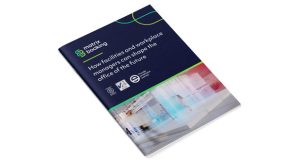Safety flooring should meet the highest standards of slip resistance. Paul Rogers of Forbo Flooring Systems explains how floor coverings are tested and rated
Having a fall in the workplace is bad news for both employers and employees. The Health and Safety Executive (HSE) states that one-third of all major workplace injuries are from slips and falls, and account for over half of all reported injuries to members of the public. Some of the main causes quoted are wet or contaminated floors, poor housekeeping, uneven floor surfaces and unsuitable floor coverings.
Whether you’re looking for safety flooring for a busy kitchen, the entrance of a building, or a wet and potentially slippery changing room, it’s important to note that there is an individual flooring solution to suit each and every scenario. A commercial kitchen area which could have cooking oil or grease on the floor will need a safety flooring that is higher in friction than the flooring used in a building’s reception area, where the main contaminants are likely to be water and dirt walked in from the outside.
The first element to consider when looking at safety flooring is how they are tested and what the slip ratings mean.
The pendulum test is the method recommended by the HSE to assess the slip resistance of floor surfaces. The test can assess slip resistance in both dry and contaminated conditions, and measures the coefficient of friction of a floor surface to provide a slip potential classification. Pendulum testing is used for laboratory testing to provide ex-factory slip resistance values, on site to provide ‘as installed’ test results, and as part of investigations into slip-related incidents. A pendulum test value (PTV) of 36 or higher is classified as low slip risk.
Ramp test ratings, giving an R value, are also used to classify slip resistance. It’s a common misconception that R10 floor coverings are extremely slip-resistant; some people believe the scale starts at R1, when in fact it starts at R9. Ramp test values are based on ex-factory testing and do not take account of changes in slip-resistant properties that could occur during the working life of the floor covering. DIN 51130 ramp test values should not, therefore, be considered in isolation.
Another important factor to consider is the long-term slip resistance of flooring in use. EN 13845:2017 is the European standard for PVC floor coverings with particle-based (carborundum or cork, for example) enhanced slip resistance, commonly referred to as safety floors. The test methods are wet tests, both barefoot and with footwear (shod), based on the ramp test and the pendulum test. Products can be classified as ESf (enhanced slip for use with footwear) or ESb (enhanced slip for barefoot use), or both.
While the performance classifications are based on ex-factory testing, the standard does include a durability (abrasion) test to support claims of sustainable slip resistance throughout the life of the floor covering.
Understanding the slip resistance of floor surfaces and how it is assessed when selecting the correct floor covering for an area is just one, albeit important, aspect of pedestrian safety.
People are unlikely to slip on a clean, dry floor. Prevention of contamination, prompt and effective removal of contaminants and use of correct and effective cleaning methods are just a few examples of practical advice offered by the HSE to help reduce slips and trips. Pendulum testing can be used to provide a useful insight into the effectiveness of cleaning and maintenance or to monitor the performance of a floor surface over its service life.
Use of an effective entrance flooring system has a key role in pedestrian safety and can reduce slip risk and maintenance costs by removing contamination and dirt being trafficked into a building, or between different areas of a building. Independent testing by Cleaning Research International has shown that by installing Forbo’s Coral entrance matting, for example, up to 95 per cent of dirt and moisture can be removed from the soles of shoes within six steps, removing contamination at the source. This can reduce cleaning time by up to 65 per cent.
Don’t slip up on your Health & Safety duties during wintery weather says Lee Fox, Sales and MD of mat experts Kleen-Tex
Entering a building during wet and wintery conditions poses a major slip hazard. Most slips occur in wet or contaminated underfoot conditions, and most are due to poor housekeeping. Yet the solution is both simple and low cost. It all boils down to having an effective matting system.
An intelligent choice of mats not only minimises your health and safety risk but has the additional benefit of reducing overall cleaning costs, which can eat into building maintenance budgets. Yet all too often, areas of high footfall are graced by a single, inappropriate mat which all too soon becomes overwhelmed by the assault on its capabilities.
Mats are purchased on the basis of looks and cost with little thought about the job they are designed to do. We often see mats which are too small to cope with the high levels of footfall and quickly become saturated and unfit for purpose.
Another common error is not to change the mats frequently, which again negates the effectiveness. There is a lot more to mats than meets the eye and to get the most from them it’s important to choose the right mat for the required application.
 Where wet and wintry conditions are concerned, Kleen-Tex advocates the use of primary, secondary and tertiary mats to reduce significantly the risk of slips and trips. These mats each undertake a particular function. The primary mat takes away the big chunk of loose grit and some initial moisture. The secondary mat will soak up more moisture and any remaining grit and the tertiary mat soaks up the residue, ensuring footwear is as clean and as dry as possible before entering the main part of the building.
Where wet and wintry conditions are concerned, Kleen-Tex advocates the use of primary, secondary and tertiary mats to reduce significantly the risk of slips and trips. These mats each undertake a particular function. The primary mat takes away the big chunk of loose grit and some initial moisture. The secondary mat will soak up more moisture and any remaining grit and the tertiary mat soaks up the residue, ensuring footwear is as clean and as dry as possible before entering the main part of the building.
During bad weather, this kind of matting system can help reduce the risk of slips and trips by up to 50 per cent, and can also help keep your floors cleaner for longer. Any FM will tell you that wet weather spells bad news for their cleaning budgets, and when it’s combined with icy conditions where salt and grit is used extensively, these costs can really ramp up.
Mats should be inspected regularly, particularly during bad weather, to ensure that they remain fit for purpose. As with many products, it does pay to invest in a better quality mat, choosing mats engineered from nitrile rubber and high twist nylon for durability and non-slip.




